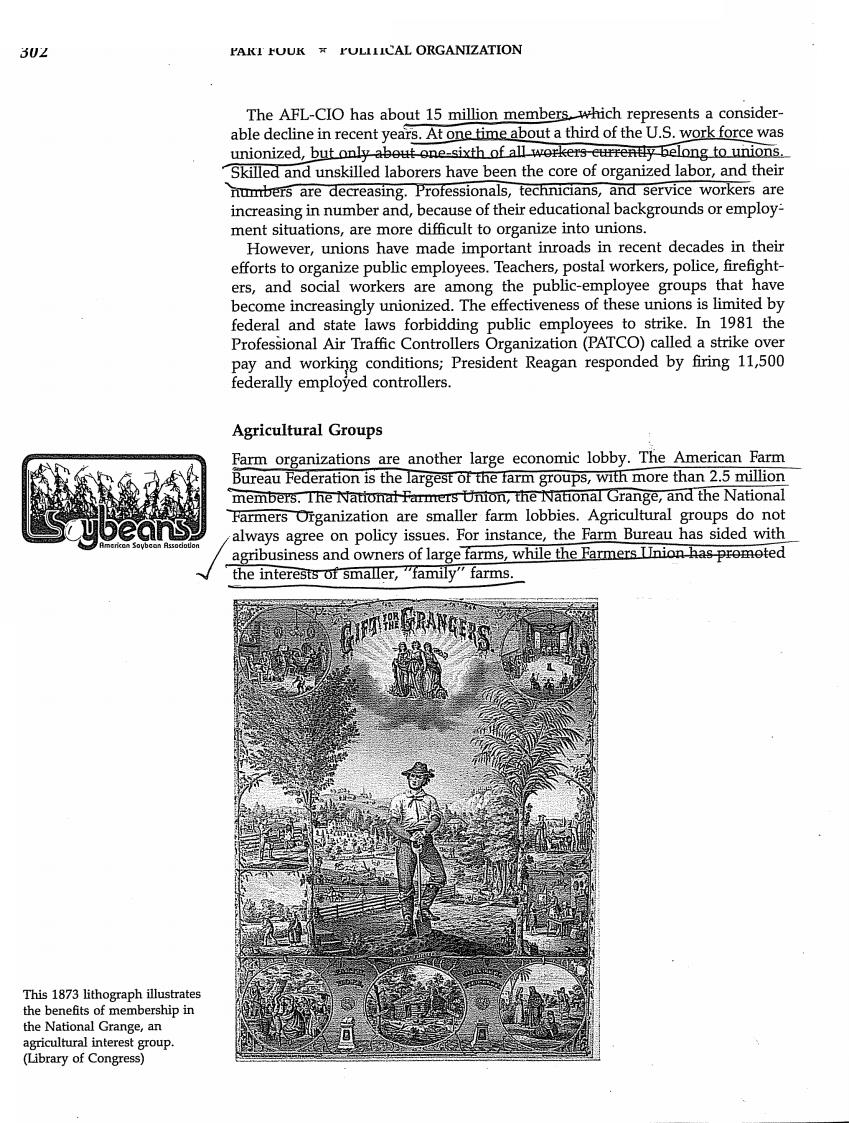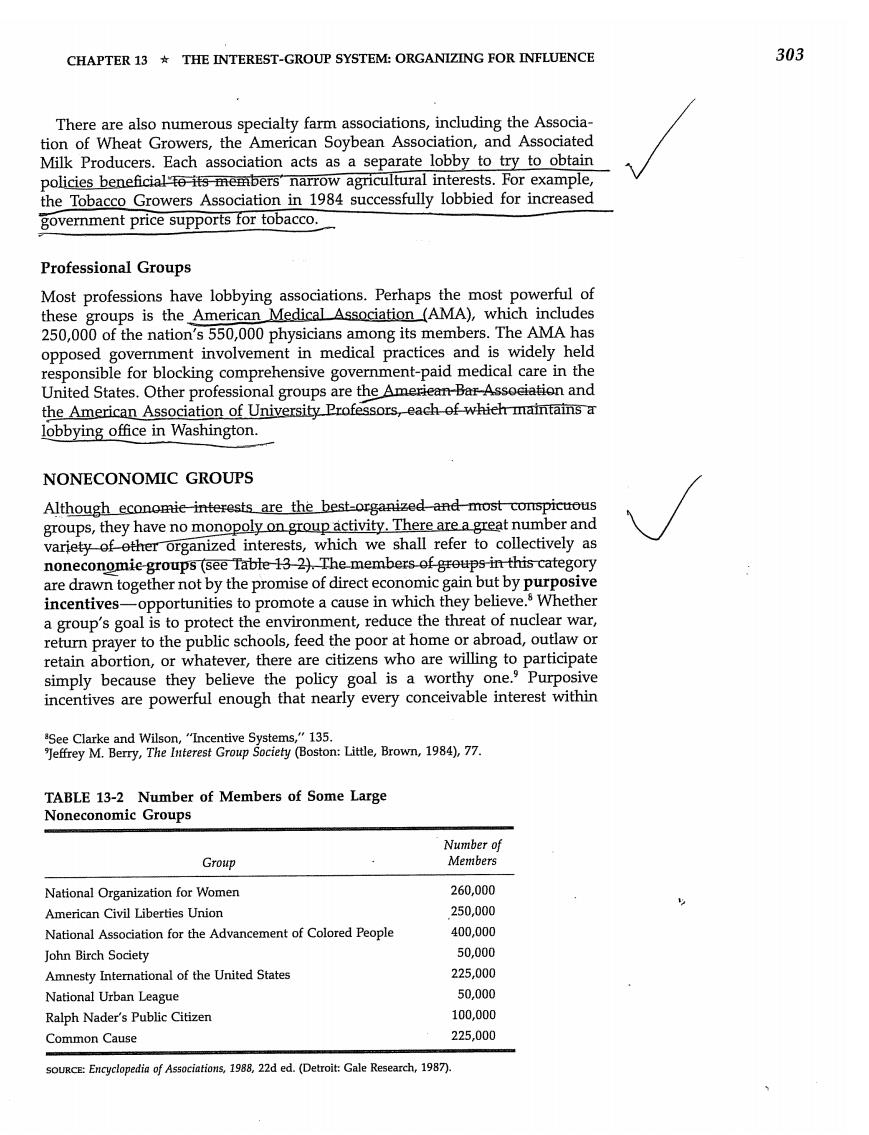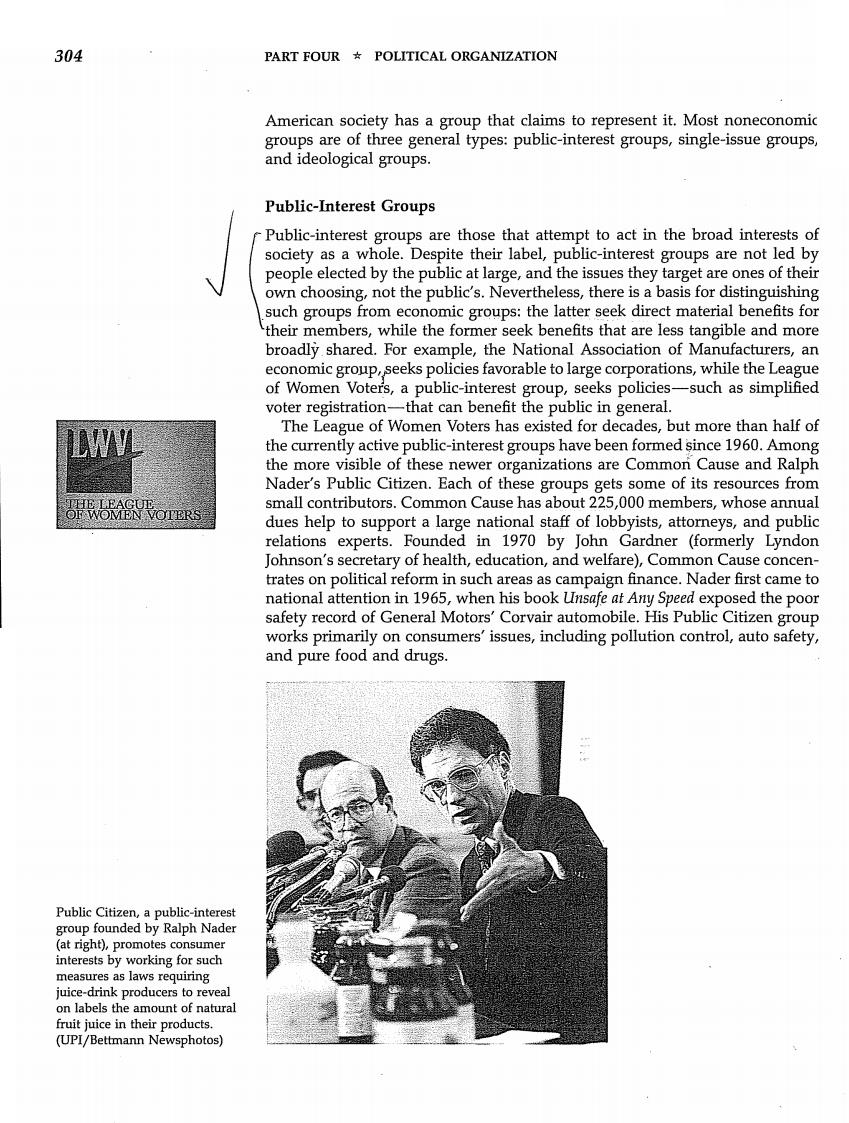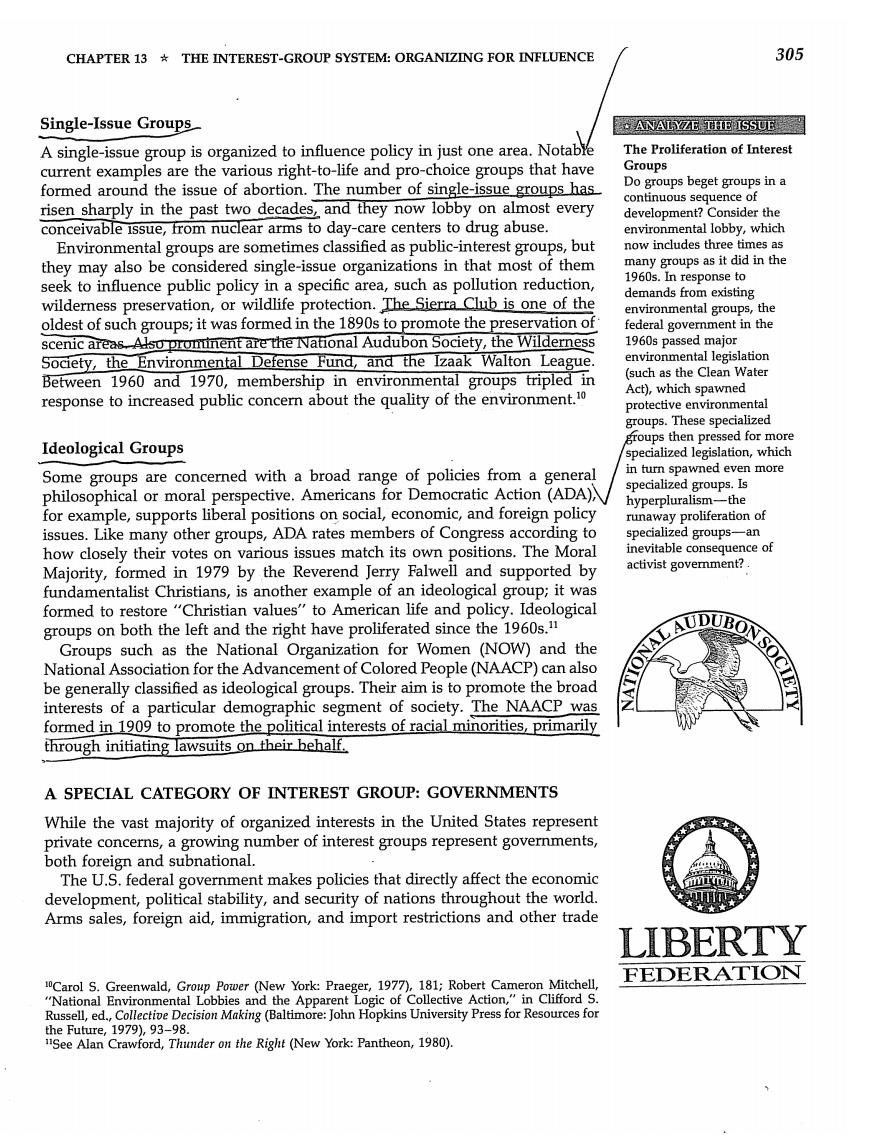
CHAPTER 13 THE INTEREST-GROUP SYSTEM:ORGANIZING FOR INFLUENCE 301 Chamber has a Washington headquarters located near the White House with a support staff of more than four hundred employees.Because the Chamber of Commerce and the NAM represent firms of various types,they generally lobby for policies beneficial to the business sector as a whole. Business is also organized through trade associations confined to a single industry.These associations vary enormously in their lobbying budgets;for example,the American Petroleum Institute and the National Association of Home Builders have annual budgets of $10 million each,whereas the Bow Tie Manufacturers Association and the Post Card Manufacturing Association each spend only $10,000 annually.Trade associations carry on the bulk of corporate lobbying.Because each trade association represents a single industry,it can promote the interests of member corporations even when these interests conflict with those of business generally.Thus,while the Chamber of Commerce promotes a free-trade policy,some trade associations seek protective tariffs because their member firms need barriers against foreign competition. Labor Groups Since the 1930s,organized labor has been politically active on a large scale.Its AAA goal has been to promote policies that benefit workers in general and union members in particular.In 1988,for example,organized labor worked hard and successfully for passage of legislation requiring companies to give workers sixty days'notice before they closed a plant or laid off employees. Although some independent unions,such as the United Mine Workers,lobby KERS DF AMERICA 31n 米 actively,the dominant labor group is the AFL-CIO,which maintains its national OM headquarters in Washington,D.C.The AFL-CIO has more than one hundred 3NIW O3LINN-ORGANIZED ONE affiliated unions,including the International Brotherhood of Electrical Workers, the Sheet Metal Workers,the Communication Workers of America,and,as of 1987,the giant International Brotherhood of Teamsters. AFLCIO The AFL-CIO has the largest membership of any organization devoted to promoting the interests of labor.OJim West/Impact Visuals)

302 FAKI FUUK FULILICAL ORGANIZATION The AFL-CIO has about 15 million members.which represents a consider- able decline in recent years.At one time about a third of the U.S.work force was unionized,but only abeut one-sixth of all workers currently belong to unions. Skilled and unskilled laborers have been the core of organized labor,and their numbers are decreasing.Professionals,technicians,and service workers are increasing in number and,because of their educational backgrounds or employ- ment situations,are more difficult to organize into unions. However,unions have made important inroads in recent decades in their efforts to organize public employees.Teachers,postal workers,police,firefight- ers,and social workers are among the public-employee groups that have become increasingly unionized.The effectiveness of these unions is limited by federal and state laws forbidding public employees to strike.In 1981 the Professional Air Traffic Controllers Organization(PATCO)called a strike over pay and working conditions;President Reagan responded by firing 11,500 federally employed controllers. Agricultural Groups Farm organizations are another large economic lobby.The American Farm Bureau Federation is the largest of the farm groups,with more than 2.5 million members.The National Farmers Union,the National Grange,and the National Farmers Organization are smaller farm lobbies.Agricultural groups do not always agree on policy issues.For instance,the Farm Bureau has sided with agribusiness and owners of large farms,while the Farmers Union has promoted the interests of smaller,"family"farms. This 1873 lithograph illustrates the benefits of membership in the National Grange,an agricultural interest group. (Library of Congress)

CHAPTER 13 THE INTEREST-GROUP SYSTEM:ORGANIZING FOR INFLUENCE 303 There are also numerous specialty farm associations,including the Associa- tion of Wheat Growers,the American Soybean Association,and Associated Milk Producers.Each association acts as a separate lobby to try to obtain policies beneficial to its members'narrow agricultural interests.For example, the Tobacco Growers Association in 1984 successfully lobbied for increased government price supports for tobacco. Professional Groups Most professions have lobbying associations.Perhaps the most powerful of these groups is the American Medical Association (AMA),which includes 250,000 of the nation's 550,000 physicians among its members.The AMA has opposed government involvement in medical practices and is widely held responsible for blocking comprehensive government-paid medical care in the United States.Other professional groups are the Ameriean-Bar-Assoeiation and the American Association of University Professors,each of whieh maintains a lobbying office in Washington. NONECONOMIC GROUPS Although economie interests are the best-organized and most conspicuous groups,they have no monopoly on group activity.There are a great number and variety-of ether organized interests,which we shall refer to collectively as noneconomie groups (see Table 13 2).The members of groups in this category are drawn together not by the promise of direct economic gain but by purposive incentives-opportunities to promote a cause in which they believe.s Whether a group's goal is to protect the environment,reduce the threat of nuclear war, return prayer to the public schools,feed the poor at home or abroad,outlaw or retain abortion,or whatever,there are citizens who are willing to participate simply because they believe the policy goal is a worthy one.3 Purposive incentives are powerful enough that nearly every conceivable interest within See Clarke and Wilson,"Incentive Systems,"135. Jeffrey M.Berry,The Interest Group Society (Boston:Little,Brown,1984),77. TABLE 13-2 Number of Members of Some Large Noneconomic Groups Number of Group Members National Organization for Women 260,000 American Civil Liberties Union 250,000 National Association for the Advancement of Colored People 400,000 John Birch Society 50,000 Amnesty International of the United States 225,000 National Urban League 50,000 Ralph Nader's Public Citizen 100,000 Common Cause 225,000 soURcE:Encyclopedia of Associations,1988,22d ed.(Detroit:Gale Research,1987)

304 PART FOUR POLITICAL ORGANIZATION American society has a group that claims to represent it.Most noneconomic groups are of three general types:public-interest groups,single-issue groups, and ideological groups. Public-Interest Groups Public-interest groups are those that attempt to act in the broad interests of society as a whole.Despite their label,public-interest groups are not led by people elected by the public at large,and the issues they target are ones of their own choosing,not the public's.Nevertheless,there is a basis for distinguishing such groups from economic groups:the latter seek direct material benefits for their members,while the former seek benefits that are less tangible and more broadly shared.For example,the National Association of Manufacturers,an economic group,seeks policies favorable to large corporations,while the League of Women Voters,a public-interest group,seeks policies-such as simplified voter registration-that can benefit the public in general. The League of Women Voters has existed for decades,but more than half of the currently active public-interest groups have been formed since 1960.Among the more visible of these newer organizations are Common Cause and Ralph Nader's Public Citizen.Each of these groups gets some of its resources from LEAGUE small contributors.Common Cause has about 225,000 members,whose annual OF WOMEN VOTERS dues help to support a large national staff of lobbyists,attorneys,and public relations experts.Founded in 1970 by John Gardner (formerly Lyndon Johnson's secretary of health,education,and welfare),Common Cause concen- trates on political reform in such areas as campaign finance.Nader first came to national attention in 1965,when his book Unsafe at Any Speed exposed the poor safety record of General Motors'Corvair automobile.His Public Citizen group works primarily on consumers'issues,including pollution control,auto safety, and pure food and drugs. Public Citizen,a public-interest group founded by Ralph Nader (at right),promotes consumer interests by working for such measures as laws requiring juice-drink producers to reveal on labels the amount of natural fruit juice in their products. (UPI/Bettmann Newsphotos)

CHAPTER 13 THE INTEREST-GROUP SYSTEM:ORGANIZING FOR INFLUENCE 305 Single-Issue Groups ANALYZ元T匝1SSU正 A single-issue group is organized to influence policy in just one area.Notabie The Proliferation of Interest current examples are the various right-to-life and pro-choice groups that have Groups formed around the issue of abortion.The number of single-issue groups has Do groups beget groups in a continuous sequence of risen sharply in the past two decades,and they now lobby on almost every development?Consider the conceivable issue,from nuclear arms to day-care centers to drug abuse. environmental lobby,which Environmental groups are sometimes classified as public-interest groups,but now includes three times as they may also be considered single-issue organizations in that most of them many groups as it did in the seek to influence public policy in a specific area,such as pollution reduction, 1960s.In response to demands from existing wilderness preservation,or wildlife protection.The Sierra Club is one of the environmental groups,the oldest of such groups;it was formed in the 1890s to promote the preservation of federal government in the scenic areas.Also prominent are the National Audubon Society,the Wilderness 1960s passed major Society,the Environmental Defense Fund,and the Izaak Walton League. environmental legislation Between 1960 and 1970,membership in environmental groups tripled in (such as the Clean Water response to increased public concern about the quality of the environment.10 Act),which spawned protective environmental groups.These specialized groups then pressed for more Ideological Groups specialized legislation,which Some groups are concerned with a broad range of policies from a general in turn spawned even more philosophical or moral perspective.Americans for Democratic Action(ADA) specialized groups.Is hyperpluralism-the for example,supports liberal positions on social,economic,and foreign policy runaway proliferation of issues.Like many other groups,ADA rates members of Congress according to specialized groups-an how closely their votes on various issues match its own positions.The Moral inevitable consequence of Majority,formed in 1979 by the Reverend Jerry Falwell and supported by activist government?. fundamentalist Christians,is another example of an ideological group;it was formed to restore "Christian values"to American life and policy.Ideological groups on both the left and the right have proliferated since the 1960s.11 Groups such as the National Organization for Women (NOW)and the National Association for the Advancement of Colored People(NAACP)can also be generally classified as ideological groups.Their aim is to promote the broad interests of a particular demographic segment of society.The NAACP was formed in 1909 to promote the political interests of racial minorities,primarily through initiating lawsuits on their behalf. A SPECIAL CATEGORY OF INTEREST GROUP:GOVERNMENTS While the vast majority of organized interests in the United States represent private concerns,a growing number of interest groups represent governments, both foreign and subnational. The U.S.federal government makes policies that directly affect the economic development,political stability,and security of nations throughout the world. Arms sales,foreign aid,immigration,and import restrictions and other trade LIBERTY FEDERATION 10Carol S.Greenwald,Group Power (New York:Praeger,1977),181;Robert Cameron Mitchell, "National Environmental Lobbies and the Apparent Logic of Collective Action,"in Clifford S. Russell,ed.,Collective Decision Making(Baltimore:John Hopkins University Press for Resources for the Future,1979),93-98. iSee Alan Crawford,Thunder on the Right(New York:Pantheon,1980)